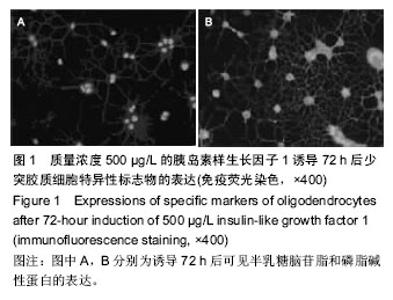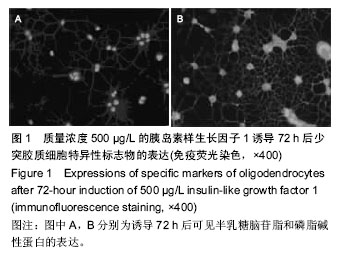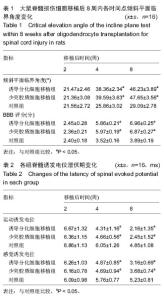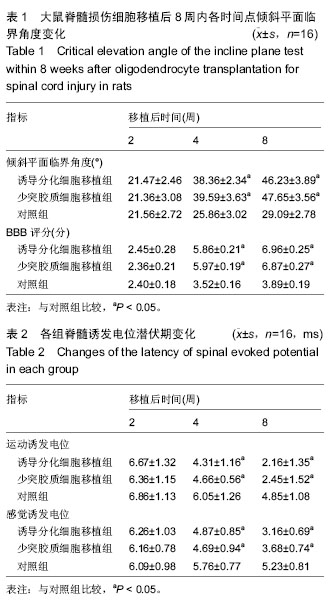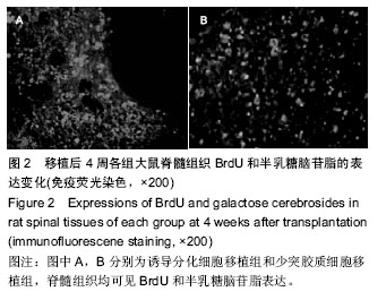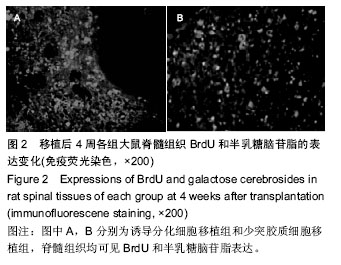| [1] Zeger M, Popken G, Zhang J, et al. Insulin-like growth factor type 1 receptor signaling in the cells of oligodendrocyte lineage is required for normal in vivo oligodendrocyte development and myelination. Glia. 2007;55(4):400-411.
[2] Hsieh J, Aimone JB, Kaspar BK, et al. IGF-1 instructs multipotent adult neural progenitor cells to become oligodendrocytes. J Cell Biol. 2004;164(1):111-122.
[3] McCarthy KD, DeVellis J. Preparation of separate astroglial and oligodendroglia cell cultures from rat cerebral tissue. J Cell Biol. 1980;85:890.
[4] Givogri Ml, Galbiati F, Fasano S, et al. Oligodendroglial progenitor cell therapy limits central neurological deficits in mice with metachromatic leukodystrophy. J Neurosci. 2006;26(12):3109.
[5] Myckatyn TM, Mackinnon SE, McDonald JW. Stem cell transp1antation and other nove1 techniques for promoting recovery fro m spinal cord injury. Transplant Immunol. 2004;12(3-4):343.
[6] Nagy RD, Tsai BM, Wang M, et al. Stem cell transplantation as a therapeutic approach to organ failure. J Surg Res. 2005;129(1):152.
[7] Reynolds BA, Weiss S. Generation of neurons and astrocytes from isolated cells of the adult mammalian central nervous system. Science. 1992;255(5052): 1707.
[8] Eriksson PS, Perfilieva E, Bjork-Eriksson T, et al. Neurogenesis in the adult human hippocampus. Nat Med. 1998;4(11):1313.
[9] Carlo-Stella C, Gianni MA. Biology and clinical applications of marrow mesenchymal stem cells. Pathol Biol (Paris). 2005;53(3):162.
[10] Ryden M, Dicker A, Gotherstmom C, et al. Functional characterization of human mesenchymal stem cell-derived adipocytes. Biochem Biophys Res Commun. 2003;311(2):391.
[11] Direkze NC, Forbes SJ, Brittan M, et al. Multiple organ engraftment by bone marrow derived myofibroblasts and fibroblasts in bone marow transplanted mice. Stem Cells. 2003;21(5):514.
[12] Hassan HT, El-Sheemy M. Adult bone-marow stem cells and their potential in medicine. J R Soc Med. 2004; 97(10):465.
[13] Emery B. Regulation of oligodendrocyte differentiation and myelination. Science. 2010;330(6005):779-782.
[14] Yang LY,Cui H,Cao T.Negative regulation of miRNA-9 on oligodendrocyte lineage gene 1 during hypoxic- ischemic brain damage. Neural Regen Res. 2014; 9(5):513-518.
[15] Son YJ.Synapsing with NG2 cells (polydendrocytes), unappreciated barrier to axon regeneration? Neural Regen Res. 2015;10(3):346-348.
[16] Karlsson C, Brantsing C, Svensson T, et al. Related Articles, Links Differentiation of human mesenchymal stem cells and articular chondrocytes: analysis of chondrogenic potential and expression pattern of differentiation-related transcription factors. J Orthop Res. 2007;25(2):152-163.
[17] Kim S, Honmou O, Kato K, et al. Neural differentiation potential of peripheral blood- and bone-marrow- derived precursor cells. Brain Res. 2006;1123(1): 27-33.
[18] Bai L, Caplan A, Lennon D, et al. Human mesenchymal stem cells signals regulate neural stem cell fate. Neurochem Res. 2007;32(2):353-362.
[19] Buntinx M, Vanderlocht J, Hellings N, et al. Characterization of three human oligodendroglial cell lines as a model to study oligodendrocyte injury: morphology and oligodendrocyte-specific gene expression. J Neurocytol. 2003;32(1):25-38.
[20] Paez PM, Garcia CI, Pasquini JM. Expression of myelin basic protein in two oligodendroglial cell lines is modulated by apotransferrin through different transcription factors. J Neurosci Res. 2006;83(4): 606-618.
[21] Kuhn J, Meissner C, Oehmichen M. Microtubule-associated protein 2 (MAP2)-a promising approach to diagnosis of forensic types of hypoxia- ischemia. Acta Neuropathol (Berl). 2005; 110(6): 579-586.
[22] Pillai R, Scintu F, Scorciapino L, et al. Human astrocytes can be induced to differentiate into cells with neuronal phenotype. Exp Cell Res. 2006;312(12): 2336-2346.
[23] Jo C, Kim H, Jo I, et al. Leukemia inhibitory factor blocks early differentiation of skeletal muscle cells by activating ERK. Biochim Biophys Acta. 2005;1743(3): 187-197.
[24] Li Y, Qiu SS, Shao Y, et al. Dickkopf-1 has an Inhibitory Effect on Mesenchymal Stem Cells to Fibroblast Differentiation. Chin Med J (Engl). 2016;129(10): 1200-1207.
[25] Soygur B, Moore H. Expression of Syncytin 1 (HERV-W), in the preimplantation human blastocyst, embryonic stem cells and trophoblast cells derived in vitro. Hum Reprod. 2016.
[26] Kodama N, Iwao T, Kabeya T, et al. Inhibition of mitogen-activated protein kinase kinase, DNA methyltransferase, and transforming growth factor-β promotes differentiation of human induced pluripotent stem cells into enterocytes. Drug Metab Pharmacokinet. 2016.
[27] Yang H, Wang J, Wang F, et al. Dopaminergic Neuronal Differentiation from the Forebrain-Derived Human Neural Stem Cells Induced in Cultures by Using a Combination of BMP-7 and Pramipexole with Growth Factors. Front Neural Circuits. 2016.
[28] Gargett CE, Gurung S. Endometrial Mesenchymal Stem/Stromal Cells, Their Fibroblast Progeny in Endometriosis, and More. Biol Reprod. 2016.
[29] Hsu YC, Kao CY, Chung YF, et al. Activation of Aurora A kinase through the FGF1/FGFR signaling axis sustains the stem cell characteristics of glioblastoma cells. Exp Cell Res. 2016.
[30] Maiese K. Novel nervous and multi-system regenerative therapeutic strategies for diabetes mellitus with mTOR. Neural Regen Res. 2016; 11(3): 372-385.
[31] Chen X, Shi C, Meng X, et al. Inhibition of Wnt/β-catenin signaling suppresses bleomycin- induced pulmonary fibrosis by attenuating the expression of TGF-β1 and FGF-2. Exp Mol Pathol. 2016.
[32] Qiao SP, Zhao YF, Li CF, et al. An alginate-based platform for cancer stem cell research. Acta Biomater. 2016;37:83-92.
[33] Yamazaki A, Yashiro M, Mii S, et al. Isoproterenol directs hair follicle-associated pluripotent (HAP) stem cells to differentiate in vitro to cardiac muscle cells which can be induced to form beating heart-muscle tissue sheets. Cell Cycle. 2016;15(5):760-765. |
